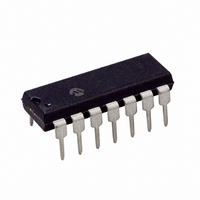PIC16F526-I/P Microchip Technology, PIC16F526-I/P Datasheet - Page 59

PIC16F526-I/P
Manufacturer Part Number
PIC16F526-I/P
Description
IC PIC MCU FLASH 1KX12 14DIP
Manufacturer
Microchip Technology
Series
PIC® 16Fr
Datasheets
1.PIC16F526-ISL.pdf
(122 pages)
2.PIC16F526-ISL.pdf
(22 pages)
3.PIC16F526-IP.pdf
(104 pages)
Specifications of PIC16F526-I/P
Program Memory Type
FLASH
Program Memory Size
1.5KB (1K x 12)
Package / Case
14-DIP (0.300", 7.62mm)
Core Processor
PIC
Core Size
8-Bit
Speed
20MHz
Peripherals
POR, WDT
Number Of I /o
11
Ram Size
67 x 8
Voltage - Supply (vcc/vdd)
2 V ~ 5.5 V
Data Converters
A/D 3x8b
Oscillator Type
Internal
Operating Temperature
-40°C ~ 85°C
Processor Series
PIC16F
Core
PIC
Data Bus Width
8 bit
Data Ram Size
67 B
Maximum Clock Frequency
20 MHz
Number Of Programmable I/os
12
Number Of Timers
1
Maximum Operating Temperature
+ 85 C
Mounting Style
Through Hole
3rd Party Development Tools
52715-96, 52716-328, 52717-734
Development Tools By Supplier
PG164130, DV164035, DV244005, DV164005, PG164120, ICE2000
Minimum Operating Temperature
- 40 C
On-chip Adc
8 bit, 3 Channel
Lead Free Status / RoHS Status
Lead free / RoHS Compliant
For Use With
AC162096 - HEADER MPLAB ICD2 PIC16F526 8/14
Eeprom Size
-
Connectivity
-
Lead Free Status / Rohs Status
Lead free / RoHS Compliant
9.0
The A/D Converter allows conversion of an analog
signal into an 8-bit digital signal.
9.1
The ADC has 4 clock source settings ADCS<1:0>.
There are 3 divisor values 16, 8 and 4. The fourth
setting is INTOSC with a divisor of 4. These settings
will allow a proper conversion when using an external
oscillator at speeds from 20 MHz to 350 kHz. Using an
external oscillator at a frequency below 350 kHz
requires the ADC oscillator setting to be INTOSC/4
(ADCS<1:0> = 11) for valid ADC results.
The ADC requires 13 T
conversion. The divisor values do not affect the number
of T
divisor values determine the length of the T
When the ADCS<1:0> bits are changed while an ADC
conversion is in process, the new ADC clock source will
not be selected until the next conversion is started. This
clock source selection will be lost when the device
enters Sleep.
9.1.1
There is no external voltage reference for the ADC. The
ADC reference voltage will always be V
9.1.2
The ANS<1:0> bits are used to configure pins for
analog input. Upon any Reset, ANS<1:0> defaults to
11. This configures pins AN0, AN1 and AN2 as analog
inputs. The comparator output, C1OUT, will override
AN2 as an input if the comparator output is enabled.
Pins configured as analog inputs are not available for
digital output. Users should not change the ANS bits
while a conversion is in process. ANS bits are active
regardless of the condition of ADON.
9.1.3
The CHS bits are used to select the analog channel to
be sampled by the ADC. The CHS<1:0> bits can be
changed at any time without adversely effecting a con-
version. To acquire an analog signal the CHS<1:0>
selection must match one of the pin(s) selected by the
ANS<1:0> bits. When the ADC is on (ADON = 1) and a
channel is selected that is also being used by the
comparator, then both the comparator and the ADC will
see the analog voltage on the pin.
2010 Microchip Technology Inc.
Note:
AD
periods required to perform a conversion. The
ANALOG-TO-DIGITAL (A/D)
CONVERTER
Clock Divisors
VOLTAGE REFERENCE
The ADC clock is derived from the instruc-
tion clock. The ADCS divisors are then
applied to create the ADC clock
ANALOG MODE SELECTION
ADC CHANNEL SELECTION
AD
periods to complete a
DD
.
AD
period.
When the CHS<1:0> bits are changed during an ADC
conversion, the new channel will not be selected until
the current conversion is completed. This allows the
current conversion to complete with valid results. All
channel selection information will be lost when the
device enters Sleep.
TABLE 9-1:
9.1.4
The GO/DONE bit is used to determine the status of a
conversion, to start a conversion and to manually halt
a conversion in process. Setting the GO/DONE bit
starts a conversion. When the conversion is complete,
the ADC module clears the GO/DONE bit. A
conversion can be terminated by manually clearing the
GO/DONE bit while a conversion is in process. Manual
termination of a conversion may result in a partially
converted result in ADRES.
The GO/DONE bit is cleared when the device enters
Sleep, stopping the current conversion. The ADC does
not have a dedicated oscillator, it runs off of the
instruction clock. Therefore, no conversion can occur in
sleep.
The GO/DONE bit cannot be set when ADON is clear.
MCLR
Conversion completed
Conversion terminated
Power-on
Wake from Sleep
Note:
It is the users responsibility to ensure that
use of the ADC and comparator simulta-
neously on the same pin, does not
adversely
monitored or adversely effect device
operation.
THE GO/DONE BIT
Event
CHANNEL SELECT (ADCS)
BITS AFTER AN EVENT
affect
PIC16F526
the
DS41326E-page 59
ADCS<1:0>
signal
CS<1:0>
CS<1:0>
11
11
11
being














